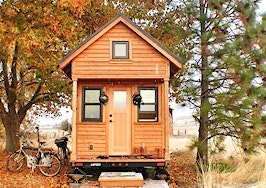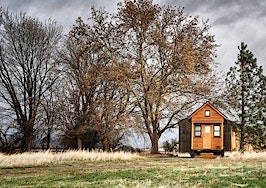Takeaways:
- Factors including the housing bubble popping, student loans and lack of jobs have led people to downsize.
- Another reason people look to tiny homes is the desire to lessen one’s carbon footprint.
- Due to economy, environment and a back-to-basics mindset, the tiny home movement isn’t just a trend — it’s a lifestyle.
Tiny houses are the next big thing, and here’s why: We are depleting our natural resources at a rate that is alarming to even the most casual of observers. Our economy is tanking; we are saddled with thousands of dollars in student loan debt; and our salaries are not increasing at the rate of inflation.
We need to do more with less.
Here are three major reasons why tiny houses are more than just a trend:
1. Economics
After the housing bubble popped, many people were left wondering what their options were — especially if they were forced to sell their homes. There is an equally large number of people recently graduated from college with thousands of dollars in student loan debt to pay off.
Being $100,000 in debt is not conducive to paying off a mortgage — especially with the current state of the economy and the difficulty of obtaining a salaried job.
With all of these factors at play, it simply makes sense to downsize. Many turn to renting, but a more attractive and potentially viable option is the purchase of a tiny house.
There’s even a Small House Society with access to a list of floor plans and tiny-home builders. Part of the appeal of tiny houses is the do-it-yourself (DIY) element: Building a typical-sized house might feel beyond one’s ability, but it’s possible for many to build a tiny home.
Much of this is a matter of logistics since the materials cost less; you can customize the floor plan and the size; and scope is not as imposing as a typical house.
Gregory Johnson, who co-founded the Small House Society, stresses that the tiny-house movement is not anti-big: “It’s about making options available for people who want to live small.”
Interestingly enough, there is a difference between tiny houses — usually classified as less than 400 square feet — and small houses — between 400 and 1,000 square feet.
However, this is all quite subjective, of course. It might seem like quibbling over semantics, but if you think of the typical size of a trailer, for example, versus one of the newer tiny houses, there is a comparable difference in size.
2. Environment
Many of us have become concerned with our carbon footprint and the impact we as humans have on the environment. When thinking about life as we know it in 2015, there are numerous reasons why folks are looking to lessen their own impact to the planet.
Reasons include widespread drought and famine, climate change with appreciable differences in temperature and global record highs in temperature, and a growing movement in shifting our resources to renewable sources of energy.
You might think it would be impossible to coexist with others in a 200-square-foot house, but it is possible. A colleague of mine, Celeste Newberry, recently interviewed Macy Miller, a tiny-house dweller who lives in Boise, Idaho.
Miller became so inspired by her experience with designing, building and living in a tiny house that she now leads workshops on the topic. Most impressively, she lives in a tiny house with her partner, her daughter and her Great Dane.
The house qualifies as tiny, by tiny-house standards, but it looks spacious — largely because of the long narrow floor plan and the clever use of vertical space.
3. Back-to-basics thinking
Beyond downsizing for economic reasons and living in a more sustainable way, many people are taking an interest in the possibilities of living off the grid.
This could be seen as a resurgence or return of the “back to the land” movement of the ’70s, or it could be seen as a natural extension of the above factors already explored.
The return to the patterns of early U.S. pioneers is reflected in the modern “buy local” movement. From an ecological standpoint, it simply makes sense to return to small-scale agriculture because it’s sustainable, it saves money in the long run, and it avoids overexpenditure of our natural resources such as water, oil and gas, which are rapidly depleting.
The shift to a reliance on renewable energy sources, such as wind and solar, simply makes sense from both an economic and an environmental standpoint, and has inspired a large number of environmental science and green technology programs in sustainability at colleges around the country.
Instead of thinking of the tiny-house movement as a real estate fad, we can think of it as an extension of a more simple way of life. This simplicity can come in many forms. Think of yurts and treehouses.
What about school buses and vans? One pioneer of this type of outside-the-box, back-to-basics thinking is Foster Huntington, whose video and upcoming book, both titled “The Cinder Cone,” will focus on his community of treehouses in Skamania, Washington, near the Columbia River Gorge.
How inspiring — at least to me. The impressive photos of tiny homes or tree homes, coupled with a reading of “Baron in the Trees,” by Italo Calvino, would convince anyone that treetop living is the way to go.
In my opinion, the tiny-house movement is more than a real estate fad. It’s a way of life. There are many ways to simplify one’s life, and a tiny house is not a bad start. If you’re inspired, too — get planning.
Daphne Stanford is host of “The Poetry Show!” at Radio Boise. You can follow her on Twitter or LinkedIn.







